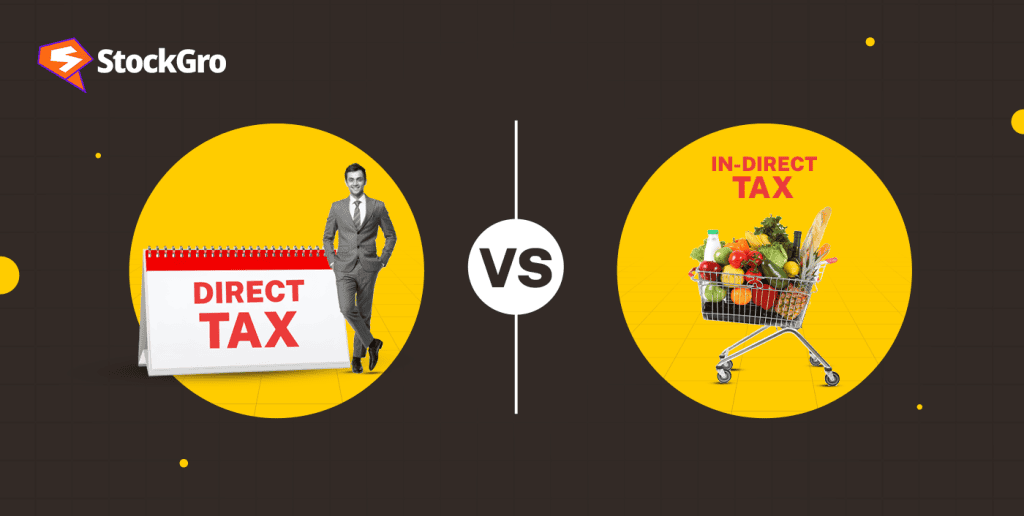
For any government, taxes are a main source of income applied to many goods and services, regardless of income level—or as a part of salary or movie watching. Taxes are paid either to the central or state governments depending on their type. The two main divisions of India’s taxation system are direct and indirect taxes. Responsible citizens should understand these taxes well. In this blog, we will understand both these taxes and their types. Let’s understand the difference between the two.
Also Read: How digital payments are transforming India’s economy
What is Direct Tax?
An individual pays direct tax to the government. A taxpayer cannot assign this obligation to another individual or company. Direct taxes are handled in India by the Department of Revenue-governed Central Board of Direct Taxes (CBDT). CBDT also helps with the planning phases of the direct tax implementation.
Types of Direct Taxes
Direct taxes in India are three-fold: securities transaction tax (STT), capital gains tax, and income tax. Below is a thorough discussion of every one of these main forms of taxes:
From an individual’s income, the Indian government most typically imposes direct taxes. It is paid straight to the government using the several income slabs recommended by the Indian Income Tax Department.
It is the tax paid by every person accumulating capital gains within the nation. One could get such increases via land, stocks, and greater investments in other areas. Usually, these taxes are paid depending on how long the investments are made for.
Any person engaged in security trading in India runs the risk of paying the securities transaction tax. These taxes must be paid apart from any possible benefits.
Advantages of Direct Tax
When it comes to direct taxes, given below are some of the advantages to consider-
- Curbs Inflation: The government increases tax rates if monetary inflation strikes the country. This increase lowers the demand for goods and services, therefore compressing inflation.
- Social and Economic Balance: Well-defined tax slabs and exemptions balance income disparities. Lower-income payers, hence, pay lesser taxes and vice versa.
Drawbacks of Direct Tax
There are some drawbacks associated with direct taxes; these are given below:
- Tax Evasion: People utilize dishonest methods to pay less than they should or avoid taxes despite strict rules.
- Burdensome: Every year, direct taxes are paid in one lump sum. They are sometimes seen as a burden. The paperwork is also time-consuming and thorough, which aggravates the situation even more.
What is Indirect Tax?
Indirect taxes are transferable taxes in which one passes on the obligation to pay to others. These taxes are handled and under control of the Central Board of Indirect Taxes and Customs (CBIC). Sales tax and service tax are two among the indirect taxes.
It is not simply a tax the government levies on an intermediary—a merchant or service provider—that is passed on to the consumer at the last pay-off. Although direct taxes are not included in prices paid for products and services, this charge is included in those costs.
Different Types of Indirect Taxes
India’s government largely receives its income via indirect taxes. Indirect taxes typically come in two forms, as covered in more detail below:
1. GST (Goods and Services Tax)
Among various indirect taxes, GST is the most widely utilized one; it replaces VAT, service tax, purchase tax, and excise duty. Based on several tax slabs, as the GST Council of India advised, GST is a complete indirect tax applied to goods and services.
2. Customs duty
It covers the expenses paid by every person who buys foreign products and services. Whether the order is received via land, air, or sea, you have to pay customs duty. This tax is thus paid on every commodity arriving from abroad.
You May Also Like: Long-term investing: A smart strategy for lasting wealth
Benefits of Indirect tax
Indirect tax benefits are given below-
- Equal Contribution: Indirect taxes guarantee that each person pays the state some meager amount. It also reaches lower-income populations, who are excluded from direct taxes.
- Non-evadable: These taxes are included in the cost of a good. One can only therefore avoid an indirect tax by not utilizing the taxable good.
Drawback of Indirect tax
Indirect taxes comprise some drawbacks, which are given below:
- Regressive: Those with lesser salaries could find it unfair since indirect taxes apply to all economic levels.
- Increased Product Price: An indirect tax applied on national goods and services increases their cost, thereby driving their higher price.
Difference between Direct vs indirect taxes
| Point of Difference | Direct Tax | Indirect Tax |
| Tax Imposition | Levied on the income of the taxpayer | Imposed directly goods and services instead of on income |
| Payment | Paid directly to the government | Paid to the government through intermediaries |
| Entity | Individuals and organisations | End users |
| Tax Payment Rate | Dependent on the profit and income | Everybody has the same tax rate. |
| Payment Transferability | It is Non-transferable | It is Transferable |
| Tax Nature | Progressive tax; increases with income growth | Regressive tax; decreases with income growth |
| Types of Tax | Income tax; wealth tax; business tax; etc. | Value-added tax; sales tax; service tax; etc. |
| Tax Collection | Difficult to collect | Relatively easier to collect |
Also Read: Form 16 or Form 16A? Know which one applies to you
Conclusion
The two main taxes that help the Indian government to generate overall income are direct and indirect taxes. Understanding these taxes could help you to understand why the government levies them and how you are helping the nation to grow. The central government directly taxes a citizen’s capital gains and income. Indirect taxes, on the other hand—those paid to middlemen—are those applied to goods and services. Every logical Indian citizen must be clear about the variations between them and know the taxes they are paying.
FAQs
Based on income or profits, direct taxes—paid by people or companies—are sent straight to the government. Two such taxes are business and income ones. Indirect taxes are applied on products and services. A middleman gathers it—perhaps a seller—then pays the government. Sales tax and GST are two examples of indirect taxes. While indirect tax can be passed on to customers via better prices, direct tax is not transferable.
The entire tax applied on goods and services is known as indirect tax. It covers taxes including GST, customs duty, or excise charge. Conversely, net indirect tax varies between government subsidies and the overall indirect tax paid. Subsidies lower the overall tax burden. Therefore, net indirect tax offers a more realistic view of government income produced following subsidy changes.
An indirect tax applies to products and services. This is not directly applied to individual income or profits. Indirect taxes include customs duty, sales tax, excise duty, and Goods and Services Tax (GST). Customers pay these taxes upon purchase of goods or services. Collecting the tax on behalf of the government, the merchants later forward it. Unlike direct taxes, indirect taxes are the same for every consumer regardless of their income or financial situation.
Yes, GST is an indirect tax. It charges the supply of goods and services. Businesses gather GST paid by consumers when they buy goods or use services. They then forward it to the government; GST replaces indirect taxes like sales tax, excise duty, and service tax, simplifying taxation. It guarantees consistent application of the tax over the nation, thereby improving the system’s transparency and ease of management.
Direct taxes include TDS or Tax Deducted at Source. It is withheld from a person’s income before the payer makes payment. Employers subtract TDS from salaries, for instance, and banks subtract it from interest accrued on deposits. This guarantees ahead-of-time tax collection. Directly paid to the government on behalf of the person or company, TDS helps determine their total income tax obligation for the fiscal year.

